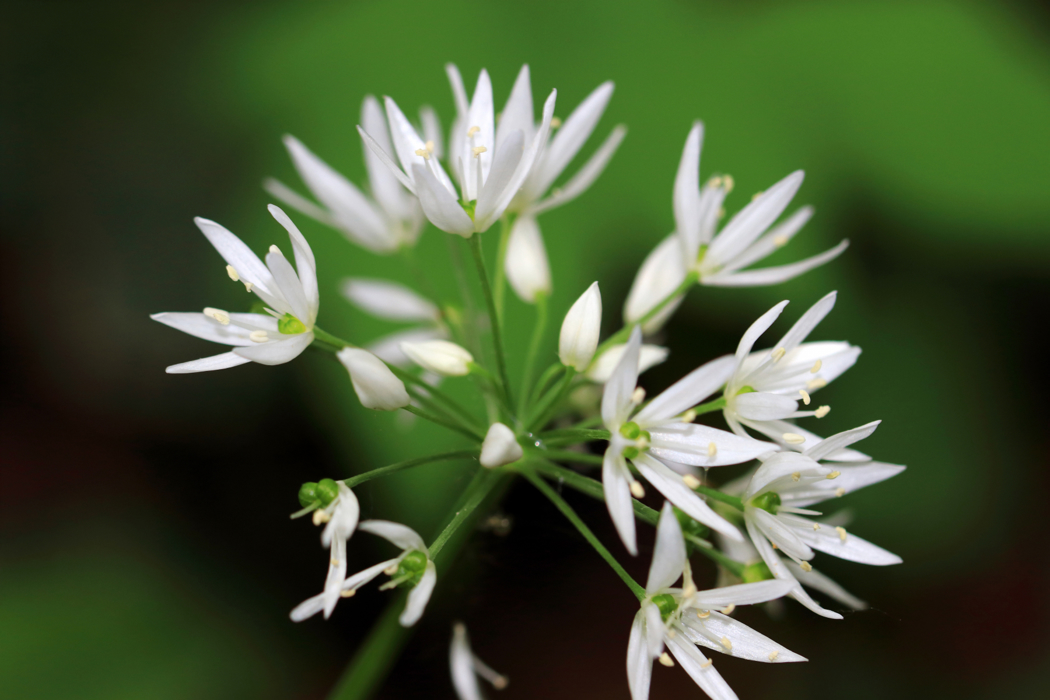If you are intending to head out into the wilds in order to pick plants for food, you should go on a course first, take an experienced picker with you, or get what you are intending to eat checked by someone who knows about plants.
You should be aware that images and information on the internet have not necessarily undergone quality assurance and may therefore be misleading and/or incorrect. The Norwegian Poison Information Centre recommends that anyone wishing to use wild garlic in cooking knows enough about the characteristics of the plant to be certain that it is 100% safe.
Wild garlic and lily of the valley

Wild garlic (left) and lily of the valley (right).
Illustration: Giftinformasjonen.
In the spring, wild garlic (Allium ursinum) is a popular plant among people who like to harvest plants for food. There are plenty of food recipes online, and it is easy to be tempted.
However, wild garlic can be confused with lily of the valley (Convallaria majalis), a poisonous plant which contains substances that act on the muscles of the heart. People confuse the two plants because the leaves of the two species are very similar.

Wild garlic (left) growing next to lily of the valley (right).
Illustration: Giftinformasjonen
Differences between wild garlic and lily of the valley
Different scents
Wild garlic is a member of the onion family (Alliaceae) and has the scent of onion or garlic. The scent becomes more obvious if you rub or break the leaves.
Lily of the valley does not have this characteristic onion smell or flavour, and scent is therefore one of the most obvious differences between the two plants before they flower.
Differences between the leaves
There are also some differences between the foliages of the two plants, but these differences can be harder to distinguish (especially in the case of young plants early in the season).
Wild garlic leaves each emanate singly on their own stem (although this is not always easy to see) and often changes from pale green to white down the stem (this is also not always obvious).
On lily of the valley, there are two leaves on each stem, often with a red-coloured sheath at the bottom (not always very easy to see).
The nerves on wild garlic leaves are also spaced further apart than those on the lily of the valley leaf.

There are slight differences in the structure of the foliage (left), as lily of the valley (left) has slightly denser nerves than wild garlic (right). The image on the right illustrates the differences in the colour of the stems of lily of the valley (left) and wild garlic (right).
Illustration: Giftinformasjonen.
Differences between the flowers
Once the plants flower, it is much easier to see the differences between them:
Wild garlic

Wild garlic has white, star-shaped flowers held in a flat to spherical head.
Illustration: Jolanta Mayerberg / Mostphotos.com
Lily of the Valley

Lily of the valley has white (pink), bell-shaped flowers grouped together in clusters of 6-12 bells on one side of the stem. They produce berries, which eventually turn red.
Illustration: Olya Solodenko / Mostphotos.com
What should I do if I have eaten lily of the valley?
Simply tasting a small piece of lily of the valley is not dangerous. The amount of toxin will be too small for it to cause severe poisoning. This applies to both children and adults.
The situation will be different if you eat large amounts of the plant, and you may need to seek medical assistance or be treated at a hospital. More information about what to do if you accidentally eat lily of the valley can be found here.
The Norwegian Poison Information Centre is available by telephone 24 hours a day on 22 59 13 00 if you are unfortunate enough to eat the wrong plant. We advise you to seek medical assistance/treatment if there is a risk that you have suffered acute poisoning.

Lily of the valley is a poisonous plant
Lily of the valley (Convallaria majalis) is poisonous and contains heart-active substances. Contact the Poison Information Center (22 59 13 00) if your child may have eaten more than 5 berries or flowers from lily of the valley. Also get in touch if the child may have eaten more than a small piece of a leaf.
Illustration: Giftinformasjonen
